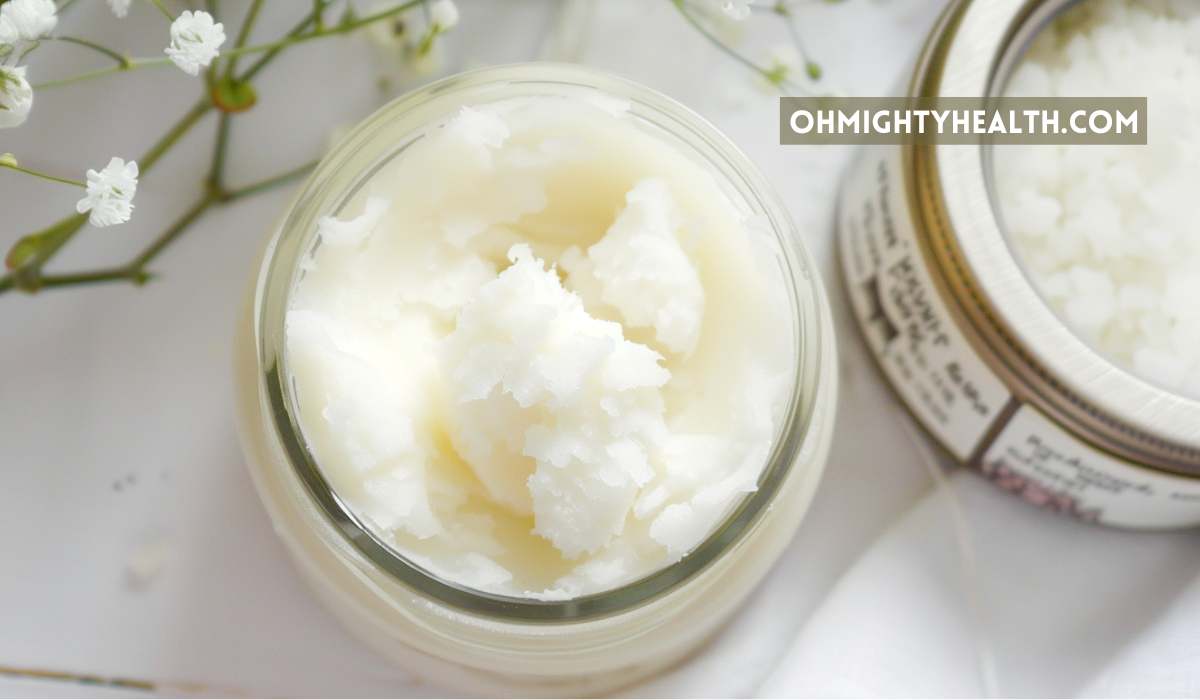DIY Deodorant Recipes with Arrowroot: Odour Busting, No Stain & No Baking Soda
Making your own deodorant is simpler than you might think. And super fun, trust me.
The goal? To remove those harsh chemicals from your life and replace them with something homemade in your kitchen.
As a certified organic skincare formulator with years of experience in crafting (and selling) my own products, I’ve witnessed the transformative power of natural ingredients.
Arrowroot powder is excellent at absorbing moisture from our underarms, and it is gentle on sensitive skin. Although it does not neutralise odours (we will look at fixes below), it is a prime example of how simple, earth-derived substances can revolutionise our skincare routines, offering effective solutions.
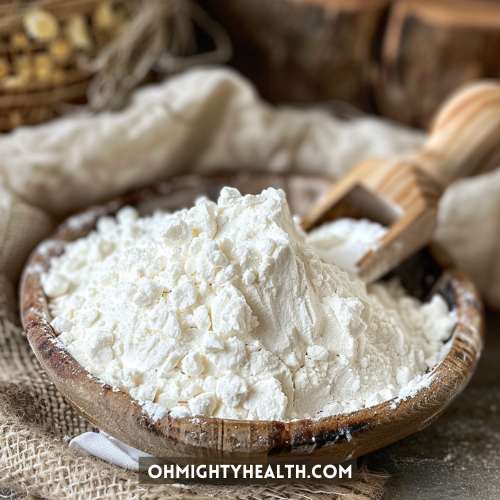
Why arrowroot powder is a fantastic option for your DIY deodorant
Arrowroot is an edible starch, obtained from the rhizomes (rootstock) of several tropical plants. It is your secret ingredient for making a deodorant that’s not only natural and effective but also gentle on your skin.
This powder shines when it comes to DIY deodorants. It offers dryness without clogging pores and smooths out the texture, making your deodorant easy to apply. It is ideal for sensitive skin types, providing a gentler alternative to baking soda (a common choice among DIY enthusiasts that I personally don’t recommend as it can irritate your skin after several uses).
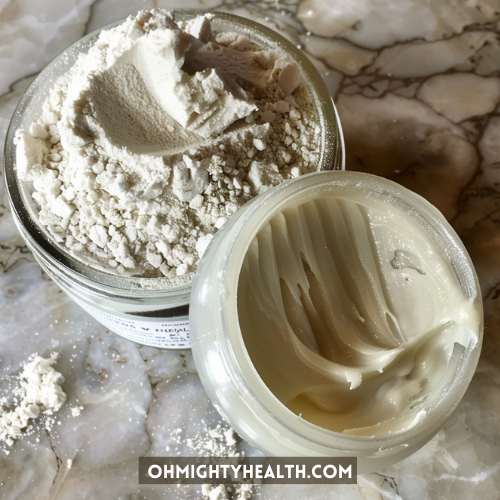
Here’s why I don’t recommend baking soda:
While popular for its deodorising properties (which means it neutralises odours), baking soda can often be too harsh for the delicate skin under your arms. Its high alkalinity (around pH 9) may disrupt the natural pH balance of your skin, leading to irritation or even damage over time.
There are mixed reviews regarding how irritant baking soda can be in a deodorant. You can read this thread, this tread and this other thread on Reddit and make up your mind.
Here’s why I recommend arrowroot powder instead:
- 1. Gentle on your skin and pH neutral: Arrowroot powder has a pH close to 7, matching the natural pH of human skin**, while baking soda’s pH is around 9, making it more alkaline and possibly disturbing the skin’s natural pH balance, leading to possible irritation.
- 2. Absorbs the moisture (yes, the sweat): It keeps you dry and doesn’t block your pores. It is better than cornstarch, which can sometimes help yeast grow on your skin because it creates a less welcoming environment for yeast and bacteria.
- 3. Offers a smooth application: Arrowroot has a silky, pleasant texture that’s easy to apply. It gives your skin a softer feel compared to the rough texture of powders like diatomaceous earth and rice flour (more comparative tables after the recipes below).
**Even though arrowroot is gentle on the skin and non-irritating for most, there is a possibility it could still cause irritation as every individual is different. Start with a small batch and conduct a patch test before regular use. If you scroll past the recipes, I created a table to help you pick the gentlest and most effective DIY deodorant powder for very sensitive skin.
Hopefully, you are as thrilled as I am in making natural deodorants. The recipes below will help you make a deodorant that not only nurtures your skin but makes the most of the powerful benefits of arrowroot.
With a little bit of your time and a touch of arrowroot magic from me, I’m excited to help you create your very own signature DIY deodorant.
Will arrowroot neutralise odours?
The below recipes combine arrowroot with other ingredients that do have natural odour-neutralising effects, such as coconut oil (which has antibacterial properties to reduce odour-causing bacteria), essential oils like tea tree or lavender (known for their antimicrobial properties), or even small amounts of baking soda for those whose skin can tolerate it. The key to a good DIY deodorant with arrowroot powder is finding the right balance of ingredients to manage both moisture and odour effectively.
Step-by-Step DIY Arrowroot Deodorant Recipes: Mix, Pour, Apply!
Below you’ll find affiliate links that might earn me a commission at no extra cost to you.
The recipes are measured in cups. Each batch is designed to last you a good while, giving you plenty of time to see how it works for you.
Don’t worry too much about getting every measurement exact on your first try. The key is to aim for at least twice as much dry ingredients as wet, generally sticking to a 2:1 ratio of dry to wet. This ensures you’ll end up with a texture that’s easy to apply and effective at keeping you dry.
If you would like to know which commercial natural deodorants I recommend (vegan, without baking soda), check Each & Every Cedar and Vanilla, Primal Pit Paste by Pretty Frank, the very simple Humble Deodorant with Bergamot and Ginger or Gaia’s Guy Lavender and Vanilla Cream Deodorant. If unsure, try them all. That’s what I always do with everything, saves me time and money in the end, as I will choose a “winner”.
1. Simple recipe for beginners

This recipe is a fantastic starting point for anyone looking to transition to natural deodorants. It’s simple, effective, and customisable, making it a fun and rewarding first project in natural skincare.
Ingredients
- Arrowroot Powder: (¼ cup), absorbs moisture and ensures a smooth application without irritating the skin.
- Coconut Oil: (¼ cup), acts as a base, moisturizes the skin, and has natural antibacterial properties.
- Shea Butter: (¼ cup), provides a creamy texture and helps soothe and condition the skin.
- Essential Oil: (10-15 drops, optional), for a pleasant scent and additional antibacterial benefits. Lavender or tea tree are great choices for their skin-friendly and odour-fighting properties.
How to make it
- Gently melt the shea butter and coconut oil together in a double boiler or in the microwave using short bursts.
- Once melted, remove from heat and stir in the arrowroot powder until fully combined and smooth.
- Add the essential oil(s) of your choice and mix well.
- Pour the mixture into an empty deodorant container or a small jar and let it cool and solidify.
Why it’s great for beginners
- It uses minimal ingredients that are easy to find and work with.
- There’s no need for precise temperature control or complicated equipment.
- The recipe is forgiving, making it easy to adjust based on personal preference or skin sensitivity.
Additional tips
- If you live in a warmer climate or find the deodorant too soft, you can add a little candelilla wax to the mixture to help it hold its shape.
- For those with very sensitive skin, you can reduce or omit the essential oils.
FAQs
- Will it stain my clothes?
- No, this recipe is designed to be non-staining. Arrowroot powder is translucent and doesn’t leave behind the residue that can cause staining, unlike some commercial deodorants.
- How long does it last?
- When applied daily, this deodorant can last for 3-4 months. Remember, a little goes a long way!
- Can I use it immediately after shaving?
- Yes, this deodorant is gentle enough to use after shaving. However, if you have very sensitive skin, test a small area first to ensure there’s no irritation.
2. Ultra-Gentle Deodorant
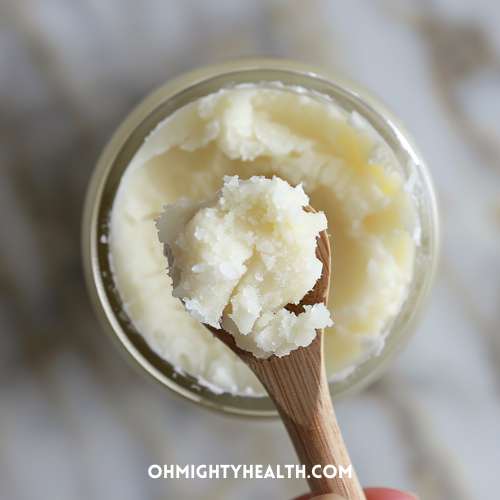
For those with ultra-sensitive skin, finding the right deodorant can be a challenge. That’s where our Ultra-Gentle Deodorant comes in—a soothing formula designed to provide effective odor control without causing irritation.
Ingredients
- Arrowroot Powder: ¼ cup, for moisture absorption without irritation.
- Shea Butter: ¼ cup, to moisturize and calm the skin.
- Coconut Oil: ¼ cup, for smooth application and its natural antibacterial properties.
- Magnesium Hydroxide: 2 tablespoons, as a gentle alternative to baking soda that neutralises odour without altering the skin’s natural pH.
How to make it
- Melt shea butter and coconut oil together.
- Stir in arrowroot powder and magnesium hydroxide until smooth.
- Add a few drops of your favourite gentle essential oil for scent.
- Pour into an empty deodorant container and let it solidify.
Why it’s special
This deodorant skips baking soda, a common irritant for those with sensitive skin, and instead relies on magnesium hydroxide to combat odours gently. Combined with the soothing properties of shea butter and coconut oil, it’s designed to keep you fresh without the risk of irritation.
Additional tips
- If you live in a warmer climate or find the deodorant too soft, consider adding around 1 tablespoon of candelilla wax to help it maintain its shape.
- For those with very sensitive skin, you can reduce or omit the essential oils.
- To boost the deodorant’s soothing properties, consider adding a teaspoon of vitamin E oil or aloe vera gel.
FAQs:
- Will it stain my clothes?
- No, this formula is designed to be non-staining, thanks to the translucent nature of arrowroot powder and the careful balance of oils and butters.
- Is it effective for heavy sweating?
- While it’s incredibly gentle, it’s best suited for light to moderate activity levels. For more intense sweating, you might want to try the Sweat-Resistant Sport Deodorant recipe below.
- Can I use it immediately after shaving?
- Yes! This formula is gentle enough to use on freshly shaved skin without causing irritation.
3. Detox Deodorant Recipe
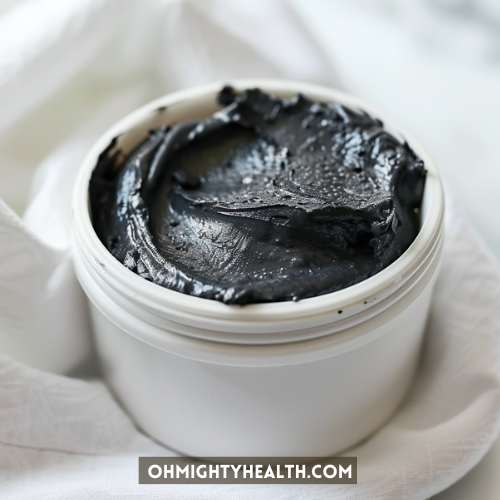
For those looking to purify their skin while staying fresh, the Detox Deodorant is a perfect choice. This formula incorporates the cleansing benefits of charcoal, making it ideal for drawing out impurities and keeping odour at bay.
Ingredients
- Arrowroot Powder: ¼ cup, for moisture absorption without irritation.
- Coconut Oil: ¼ cup, provides a smooth application and has natural antibacterial properties.
- Shea Butter: ¼ cup, to moisturize and calm the skin.
- Activated Charcoal: 1 tablespoon, known for its detoxifying properties and ability to draw out impurities.
- Bentonite Clay: 2 tablespoons, aids in detoxification and adds an extra layer of odor protection.
- Essential Oils: 10-15 drops, tea tree or peppermint for their antimicrobial and refreshing properties.
How to make it
- Melt the shea butter and coconut oil together in a double boiler.
- Once melted, remove from heat and stir in the arrowroot powder, activated charcoal, and bentonite clay until fully combined.
- Mix in the essential oils for scent.
- Pour the mixture into an empty deodorant container and allow it to solidify at room temperature or in the refrigerator for faster setting.
Why it’s special
This deodorant combines the powerful detoxifying properties of activated charcoal and bentonite clay, which work together to draw out toxins and fight odour-causing bacteria. The addition of essential oils not only adds a pleasant scent but also enhances the deodorant’s antibacterial power.
Additional tips
- If the mixture is too thick, add a little more coconut oil to achieve the desired consistency. If too soft, add a bit more arrowroot powder.
- If you have sensitive skin, start with a smaller amount of essential oils and adjust according to your preference and skin’s reaction.
- When switching to a detox deodorant, allow your body 1-2 weeks to adjust. You may experience increased sweating or odor as your body expels toxins, which is normal.
FAQs:
- Will it leave a residue on my skin or clothes?
- The activated charcoal may leave a slight residue on very light clothing but washes out easily. It’s best to apply a thin layer and allow it to absorb fully before dressing.
- How often should I apply this deodorant?
- Depending on your activity level and personal needs, you may find once a day sufficient. During the initial detox phase, you might prefer to apply twice daily.
- Can this deodorant help with underarm staining?
- Yes, the detoxifying ingredients can help reduce underarm staining over time by drawing out impurities and reducing the bacteria that contribute to staining.
4. Odour-control deodorant
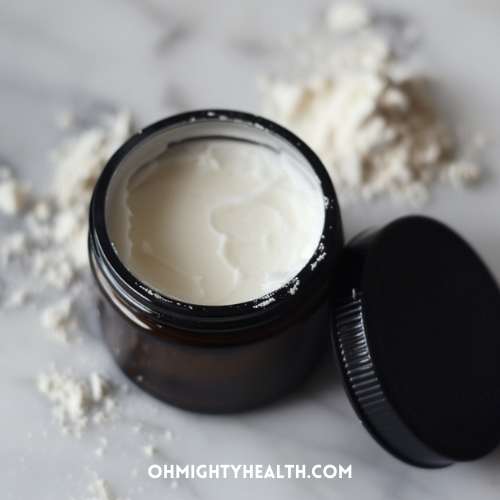
For those who prioritise keeping odours at bay throughout the day, the Odor Control Deodorant is your go-to solution. This formula is specifically designed to target and neutralise body odour, ensuring you stay fresh under any circumstances.
Ingredients
- Arrowroot Powder: (¼ cup), for its superior moisture-absorbing properties.
- Coconut Oil: (¼ cup), acts as a base and brings antibacterial qualities to combat odor.
- Shea Butter: (¼ cup), enriches the deodorant with its moisturizing and skin-soothing benefits.
- Baking Soda: (2 tablespoons), for its natural odor-neutralizing effects. For sensitive skin, reduce to 1 tablespoon or substitute with additional arrowroot powder.
- Essential Oils: (10-15 drops), choose citrus or herbal scents like lemon, bergamot, or rosemary for their strong deodorizing properties.
How to Make It
- Gently melt the shea butter and coconut oil together in a double boiler.
- Remove from heat and whisk in the arrowroot powder and baking soda until there are no lumps.
- Stir in the essential oils, customizing the scent to your preference.
- Pour into an empty deodorant container and let it cool until solid.
Why It’s Special
This deodorant leverages the odour-fighting power of baking soda, complemented by the moisture-absorbing capabilities of arrowroot powder. The essential oils not only add a refreshing scent but also contribute additional antibacterial properties to ensure all-day freshness.
Additional Tips
- Sensitivity Check: If you’re sensitive to baking soda, start with a lower amount and increase as tolerated, or opt for a baking soda-free version by using more arrowroot powder.
- Refreshing Reapplication: For extra-long days, feel free to reapply. This formula is gentle enough for multiple applications.
- Custom Scent: Feel free to experiment with different essential oil combinations to find your signature odour-control scent.
FAQs:
- Will this deodorant be effective in hot weather?
- Absolutely! The combination of ingredients is designed to offer effective odor control, even in high temperatures.
- Can I apply this deodorant immediately after shaving?
- Yes, but if you have sensitive skin or if you’re using a higher concentration of baking soda, you might want to wait a bit to avoid any potential irritation.
- How long does a batch last?
- Depending on daily usage, a single batch can last for 2-3 months. Always store it in a cool, dry place to maintain its consistency.
5. Sweat-resistant sport deodorant
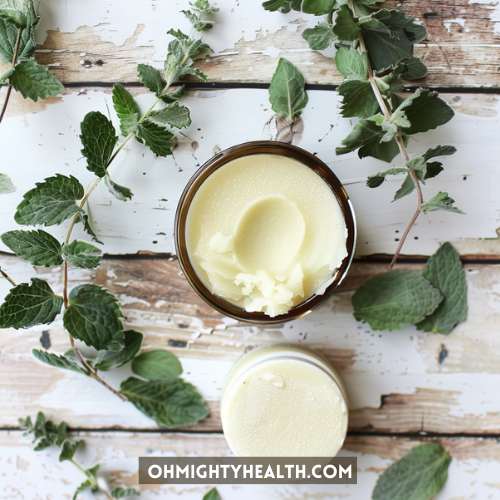
For active individuals who need a deodorant that can keep up with their high-energy lifestyle, the Sweat-Resistant Sport Deodorant is tailored for you. This robust formula is designed to offer enduring protection during workouts, runs, or any activity that gets your heart pumping.
Ingredients
- Arrowroot Powder: (¼ cup), for its exceptional moisture-wicking properties.
- Coconut Oil: (¼ cup), provides a moisture barrier and has natural antibacterial properties to combat odor.
- Shea Butter: (¼ cup), for its skin-conditioning and stabilizing effect on the formula.
- Zinc Oxide: (1 tablespoon, non-nano), acts as a natural sweat barrier and is gentle on the skin. If also neutralises odours by converting short fatty acids into odorless zinc salts. Non-irritating, suitable for sensitive skin. I love zinc oxide and use it for different formulations.
- Essential Oils: (10-15 drops), peppermint or eucalyptus for a cooling sensation and additional antimicrobial benefits.
How to Make It
- Melt the shea butter and coconut oil together over a double boiler.
- Once liquefied, remove from heat and stir in the arrowroot powder and zinc oxide until fully incorporated and smooth.
- Add the essential oils, mixing thoroughly to distribute the scent evenly.
- Pour the mixture into an empty deodorant stick container and allow it to set in a cool place.
Why It’s Special
This deodorant stands out for its inclusion of zinc oxide, providing a natural barrier against sweat while still allowing the skin to breathe. Combined with the cooling effects of chosen essential oils, it offers a refreshing feel and long-lasting odor protection, perfect for those with an active lifestyle.
Additional Tips
- Consistency Adjustment: If the deodorant is too soft for your preference, you can add a small amount of candelilla wax (for a vegan option) to firm it up.
- Cooling Effect: For an extra cooling effect, especially appreciated after a workout, increase the amount of peppermint or eucalyptus oil slightly.
- Application: Apply liberally before any physical activity. Reapply as needed for continuous protection and freshness.
FAQs:
- Is this deodorant suitable for sensitive skin?
- Yes, it’s formulated to be gentle on all skin types. However, if you’re sensitive to essential oils or zinc oxide, start with a small amount to test skin tolerance.
- How effective is this deodorant against heavy sweating?
- It’s specifically designed for high-sweat situations, offering significant moisture absorption and odour control to keep you dry and fresh.
- Can this deodorant leave white marks on clothing?
- Due to zinc oxide, there might be a slight white residue if applied heavily. To minimise this, let the deodorant absorb fully before dressing or apply a thinner layer.
I avoid commercial deodorants at all cost
Switching to DIY natural deodorants is more than just a trend; it’s a healthier choice for both you and the planet. By choosing natural ingredients, we’re not only avoiding potentially harmful chemicals but also supporting sustainable practices. It’s a win-win!
Why avoid commercial deodorants?
Commercial deodorants pack ingredients like aluminum and parabens—components some of us prefer to steer clear of. Creating your own deodorants means skipping these chemicals and slashing waste. Making a switch makes sense.
Difference between deodorant and antiperspirant
Deodorants fight odor by neutralizing bacteria, while antiperspirants block sweat by clogging your pores. For those who prefer a natural approach, deodorants are the better choice, allowing your body to sweat naturally without the use of aluminum. Making your own means keeping it simple and skin-friendly.
Is arrowroot the best choice for your DIY deodorant?
There are other powders you might be interested in exploring when it comes to your DIY deodorant.
I believe arrowroot is such a great all-rounder with plenty of benefits, as seen above, but that doesn’t mean you shouldn’t have fun and explore other lovely clays, starches and powders.
I’ve prepared a list for you, take a look:
- Bentonite Clay: Known for its ability to draw out toxins, bentonite clay is a popular choice. It helps with moisture control and has a calming effect on irritated skin.
- Kaolin Clay: This is a gentle clay known for its skin-soothing properties. Kaolin clay is suitable for sensitive skin and helps with moisture absorption without drying out the skin.
- Diatomaceous Earth (Food Grade): Made from the fossilized remains of tiny, aquatic organisms called diatoms, diatomaceous earth is effective at absorbing moisture and neutralising odors. It’s also less likely to irritate the skin compared to baking soda.
- Tapioca Starch: Similar to arrowroot powder, tapioca starch is derived from the cassava plant and is used for its moisture-absorbing properties. It provides a smooth texture to deodorants and is gentle on the skin.
- Rice Powder: Rice powder has been used for centuries in cosmetics for its oil-absorbing and skin-soothing properties. It’s suitable for sensitive skin and helps keep the underarm area dry.
- Bamboo Powder: Known for its high silica content, bamboo powder helps to absorb moisture and can also provide a soft, smooth feel to deodorant formulations.
- Magnesium Hydroxide: Often used as an alternative to baking soda, magnesium hydroxide neutralizes body odour without altering the skin’s natural pH level, making it suitable for sensitive skin.
- Activated Charcoal: Highly absorbent and detoxifying, activated charcoal is used in deodorants to absorb moisture and remove toxins, helping to keep the underarm area fresh and odour-free.
Here’s a comprehensive list that compares various powders, starches, and flours used in DIY deodorant formulations. I will hopefully help you understand their specific benefits, suitability for different skin types, and how they might be used together or as alternatives to each other.
| Ingredient | Benefits | Skin Type Suitability | Competing Qualities | Can Be Added as Extra? | Notes |
|---|---|---|---|---|---|
| Arrowroot Powder | Gentle moisture absorption, smooth texture, neutral pH. | All, especially sensitive | Less irritating than baking soda, finer than cornstarch | Yes | Ideal for sensitive skin, often used as a base ingredient. |
| Baking Soda | Neutralizes odors, absorbs moisture. | Less sensitive | Can be irritating due to alkalinity | With caution | Use sparingly if combined with gentler powders to reduce potential for skin irritation. |
| Bentonite Clay | Draws out toxins, absorbs moisture, calms skin irritation. | All, especially oily | More detoxifying than arrowroot | Yes | Avoid metal utensils when mixing due to its reactive nature. |
| Kaolin Clay | Gentle on skin, good for moisture control without drying. | All, especially dry and sensitive | Gentler than bentonite clay | Yes | Suitable for adding texture and extra moisture-absorbing properties. |
| Diatomaceous Earth (Food Grade) | Absorbs moisture, neutralizes odor, less irritating than baking soda. | All, especially sensitive | More abrasive than arrowroot, use sparingly | Yes | Ensure it’s food grade for safety. |
| Tapioca Starch | Absorbs moisture, provides a smooth application. | All, especially sensitive | Similar to arrowroot but can be less silky | Yes | Good for thickening the deodorant mixture. |
| Rice Powder | Absorbs oil and moisture, soothes skin. | All, especially oily | Finer texture than cornstarch | Yes | Can help create a matte finish on the skin. |
| Bamboo Powder | High silica content for moisture absorption, adds softness. | All | More absorbent than many other powders | Yes | Can be used to add a luxurious feel to deodorants. |
| Magnesium Hydroxide | Neutralises odour without altering skin pH, gentle on skin. | All, especially sensitive | Less irritating alternative to baking soda | Yes | Useful for those sensitive to baking soda but still need effective odour control. |
| Activated Charcoal | Detoxifies, absorbs moisture and odors. | All | More absorbent and detoxifying than most powders | With caution | Can make the deodorant dark, which may not be suitable for all users. |
| Cornstarch | Absorbs moisture, accessible and affordable. | Less sensitive | Can cause irritation or yeast growth in some | Yes | Often used in combination with other powders for its thickening and absorbing properties. |
How does arrowroot compare with other powders?
To highlight how arrowroot powder stands out against other commonly used powders in DIY deodorant formulations, let’s consider several key factors, such as effectiveness, skin compatibility, cost, availability, and any unique benefits.
| Factor | Arrowroot Powder | Other Common Powders/Flours | Notes |
|---|---|---|---|
| Effectiveness (Moisture Absorption) | High | Varies (High in bamboo powder, moderate in cornstarch and rice powder). | Arrowroot is effective at absorbing moisture, keeping the underarm area dry. |
| Skin Compatibility | Excellent for all skin types, including sensitive | Varies (e.g., baking soda can irritate sensitive skin). | Arrowroot is gentle and less likely to cause irritation, making it suitable for sensitive skin. |
| Cost | Moderate | Varies (Bentonite clay and activated charcoal may be more expensive; cornstarch is cheaper). | Arrowroot is reasonably priced, though not the cheapest option. |
| Availability | Widely available in health food stores and online | Widely available, though some, like bamboo powder, may be harder to find. | Arrowroot is easily accessible, contributing to its popularity. |
| Unique Benefits | Neutral pH, doesn’t disrupt skin’s natural balance, gentle moisture absorption | Each has unique benefits (e.g., detoxifying properties of bentonite clay). | Arrowroot’s neutral pH and gentleness make it stand out for sensitive skin formulations. |
| Texture & Feel | Provides a smooth, silky feel without caking | Varies (e.g., kaolin clay offers a smooth texture, while diatomaceous earth may feel more gritty). | Arrowroot’s fine texture is preferred for a smooth application. |
| Odour Control | Good when combined with essential oils or other odour-neutralizing ingredients | Varies (Magnesium hydroxide and baking soda offer strong odour control). | Arrowroot itself does not neutralise odours but can effectively carry other odour-controlling ingredients. |
| Versatility | Can be used in combination with other powders to enhance texture and absorption | Some powders, like baking soda, may not be as versatile due to potential skin irritation. | Arrowroot’s versatility makes it a popular base ingredient in DIY deodorant recipes. |
I thought you might want to see how arrowroot powder compares with the rest of the powders for sensitive skin to help you choose the best option if this is an important factor for you:
| Powder | Gentleness | Recommended for Sensitive Skin | Moisture Absorption | Deodorising Effectiveness | Skin Soothing Properties |
|---|---|---|---|---|---|
| Bentonite Clay | High | Yes | Good | Moderate | Yes |
| Kaolin Clay | High | Yes | Moderate | Moderate | Yes |
| Diatomaceous Earth (Food Grade) | High | Yes | Good | High | Less likely to irritate |
| Tapioca Starch | High | Yes | Good | Moderate | Yes |
| Rice Powder | High | Yes | Good | Moderate | Yes |
| Bamboo Powder | High | Yes | Good | Moderate | Yes |
| Magnesium Hydroxide | High | Yes | Good | High | Yes |
| Activated Charcoal | High | Yes | High | High | Detoxifying |
Customizing Your Arrowroot Deodorant
With arrowroot powder as your base, you’re already on the path to natural, effective odour control.
But why stop there? You can jazz it up and make it truly tailored to your needs and preferences.
Use essential oils for a personalised touch
Essential oils have the most wonderful scent! Whether you’re all about the calming energy of lavender, the freshness of citrus, or the earthy tones of patchouli, a few drops can transform your deodorant. Mix and match to find your signature scent. Check my articles on essential oils for DIY skincare for more information on safe amounts. Check the section below for some ideas on how to mix them.
Tweak the texture to your liking
Would you like your deodorant to be a bit firmer? A little softer? Play with the ratios of shea butter and coconut oil. A bit more shea butter for firmness or an extra dash of coconut oil for a softer touch. Finding your perfect texture is all part of the fun. And so easy, as you can see.
Enhance its soothing properties
Have skin that needs a little extra TLC? Ingredients like vitamin E oil or aloe vera gel can be game-changers. A teaspoon of either can boost your deodorant’s skin-soothing properties, making it a treat for your underarms.
Add a cooling sensation
For those hot summer days or post-workout freshness, consider adding a cooling element. Peppermint essential oil is not just for its scent; it can offer a refreshing, cooling sensation that’s a real pick-me-up.
Remember, making your own deodorant is about experimentation and discovery.
Start with small batches, tweak as you go, and soon you’ll have a deodorant that’s not just effective but also a perfect reflection of you.
Essential oil blends for your DIY deodorant
Essential oils not only add a beautiful, natural scent to your deodorant but can also offer additional benefits.
Experimenting with different combinations can be a lot of fun and allows you to create a truly personalised scent.
Just remember to use them safely – a little goes a long way, and it’s important to choose oils that are skin-friendly.
Here are some blend ideas to get you started, each designed to cater to different preferences and needs.
The drops mentioned are based on a standard batch size, typically around 1/2 cup to 1 cup of total product. This equates to roughly a 1-2% dilution rate, which is safe for most adults when applied to the skin, especially in sensitive areas like the underarms.
For Freshness:
- Peppermint & Lemon: Combine 5 drops of peppermint with 10 drops of lemon for a crisp, invigorating scent that wakes you up and keeps you feeling fresh.
For Relaxation:
- Lavender & Chamomile: Mix 8 drops of lavender with 7 drops of chamomile. This blend is perfect for soothing the skin and calming the mind.
For Energy:
- Orange & Grapefruit: Use 10 drops of orange with 5 drops of grapefruit for a citrusy, energizing boost that lasts all day.
For Earthy Tones:
- Patchouli & Cedarwood: Blend 5 drops of patchouli with 10 drops of cedarwood for a deep, grounding aroma that also offers antibacterial benefits.
Antibacterial Power:
- Tea Tree & Eucalyptus: Combine 10 drops of tea tree oil with 5 drops of eucalyptus for their strong antimicrobial properties, ideal for keeping odors at bay.
Remember, essential oils are potent, so it’s always a good idea to do a patch test before adding them to your deodorant, especially if you have sensitive skin.
Application & storage to keep your lovely DIY deodorant fresh!
Applying your deodorant
When it comes to using your DIY arrowroot deodorant, a little goes a long way.
I usually recommend scooping out a pea-sized amount with your fingers and gently rubbing it onto your underarms.
Make sure your skin is clean and dry to ensure the best absorption.
It is really that simple. This method helps spread the deodorant evenly, ensuring you stay fresh all day without any fuss.
One thing I love about homemade deodorants is how they feel on the skin. Unlike some commercial products that can feel sticky or greasy, arrowroot-based deodorants leave a soft, smooth finish. Just remember, if you’re switching from a commercial deodorant or antiperspirant, give your body a couple of weeks to adjust. It’s all part of the journey to natural well-being.
Storing your DIY deodorant
Storing your homemade deodorant is key to maintaining its freshness and effectiveness.
I always recommend keeping it in a cool, dry place away from direct sunlight. This helps preserve its texture and scent.
If you’ve made a batch during warmer months, consider storing it in the refrigerator.
Not only does this keep it firm, but it also offers a refreshing sensation upon application.
For those who love to travel, transferring your deodorant into a small, airtight container is a great way to keep it handy on the go. Just make sure the container is clean and dry before adding your deodorant. This simple step helps prevent any bacteria growth, ensuring your DIY deodorant remains as effective and safe as the day you made it.
How about using arrowroot beyond the deodorant?
Discover other beauty hacks and uses for arrowroot powder in your daily routine
Arrowroot isn’t just for deodorants; it’s a versatile beauty ingredient I love using in various ways.
One of my favorites is as a natural dry shampoo. It’s perfect for those days when you’re in a rush.
Just a light dusting at the roots, and it absorbs excess oil, leaving your hair looking fresh.
Plus, it’s gentle on the scalp and free from the harsh chemicals found in many store-bought dry shampoos.
Another fantastic use for arrowroot powder is as a setting powder in your makeup routine.
Its fine, super-silky texture makes it perfect for giving your makeup a smooth, matte finish without clogging pores.
Just apply a light dusting over your foundation with a fluffy brush.
It’s an affordable and natural alternative to commercial setting powders, and it works wonders for keeping your makeup in place all day.
You can also use it as a natural body powder for keeping skin dry and comfortable, especially in hot weather or after a workout.
Arrowroot can help keep feet dry and odour-free. Just sprinkle some inside your shoes or socks.
Mix with aloe vera gel for a soothing post-shave treatment to calm irritation and razor bumps.
Your journey to natural deodorants
Embarking on the DIY deodorant journey opens up a world of customisation, allowing you to create a product that not only works well but also aligns with your ethical and health-conscious values.
By choosing natural ingredients like arrowroot powder, you’re taking a step towards a more sustainable and skin-friendly lifestyle.
Remember, the key to a successful transition to natural deodorant is patience and willingness to experiment.
Your perfect formula is waiting to be discovered.
Share your recipes!
I’d love to hear about your DIY deodorant adventures!
Have you found a winning recipe or a favourite scent combination?
Maybe you’ve discovered another innovative use for arrowroot powder in your beauty routine?
Share your stories, tips, and questions in the comments below.
Let’s continue to inspire and learn from each other on this journey to natural well-being!

